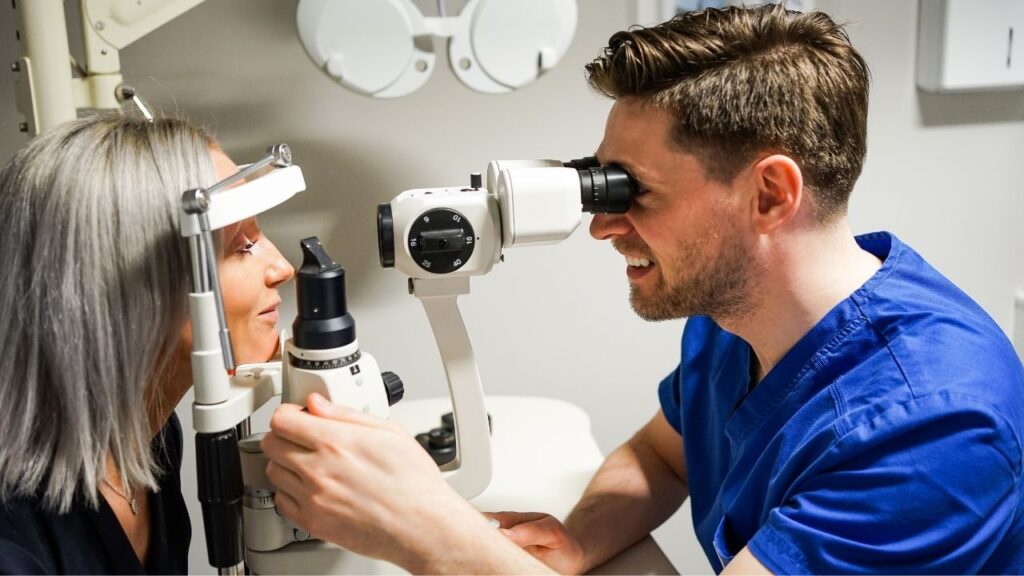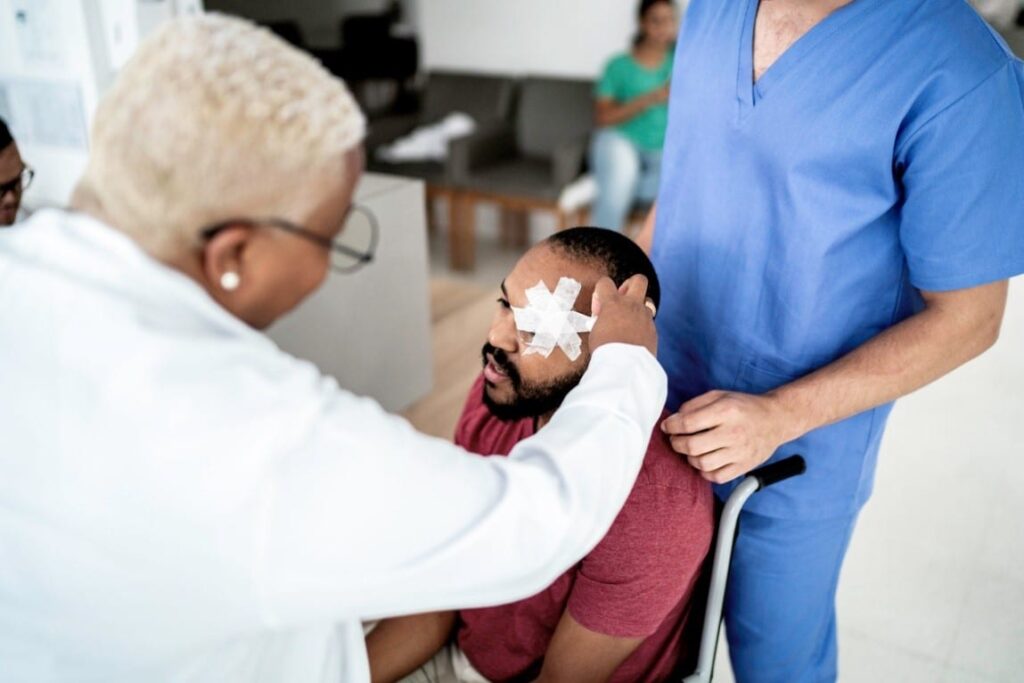Advancements in the field of retinal treatments have brought new hope for individuals suffering from various vision impairments. With a better understanding of retinal diseases and the development of innovative treatment techniques, researchers and doctors have made significant progress in restoring vision and improving the quality of life for patients. This article explores the basics of retinal diseases, the evolution of retinal treatments, breakthrough technologies, potential future developments, and the impact of these advancements on patients.
Understanding the Basics of Retinal Diseases
The retina, a thin layer of tissue lining the back of the eye, plays a crucial role in our ability to perceive light and process visual information. It contains millions of photoreceptor cells that convert light into electrical signals that are then transmitted to the brain. However, various diseases and conditions can affect the functioning of the retina and lead to retinal damage symptoms.
One fascinating aspect of the retina is its incredible sensitivity to light. The photoreceptor cells in the retina, known as rods and cones, are specialized cells that respond to different levels of light intensity. Rods are responsible for vision in low-light conditions, while cones are essential for color vision and detail in bright light. This intricate system allows us to perceive a wide range of visual information, from dimly lit scenes to vibrant colors.
See Also: Understanding Retinal Disorders and Treatment Options Available

The Role of the Retina in Vision
The retina acts as a vital interface between the external world and our perception of it. Light enters the eye and passes through the cornea and lens before reaching the retina. The photoreceptor cells in the retina then capture the light and convert it into electrical signals that are sent to the brain via the optic nerve. This process allows us to see and interpret the visual world.
Moreover, the retina is not just a passive receiver of light signals; it also plays a crucial role in processing visual information. Different regions of the retina are responsible for specific aspects of vision, such as central vision, peripheral vision, and motion detection. This complex network of cells and pathways within the retina ensures that our brain receives a detailed and coherent visual representation of the world around us.
Common Retinal Diseases and Their Impact on Vision
Several retinal diseases, such as age-related macular degeneration (AMD), diabetic retinopathy, and retinitis pigmentosa, can severely impact vision and lead to varying degrees of visual impairment. These conditions can cause blurred or distorted vision, blind spots, or complete loss of vision in severe cases. Understanding these diseases is crucial for developing effective treatment strategies.
Each retinal disease has its unique characteristics and effects on vision. For example, AMD primarily affects the macula, the central part of the retina responsible for sharp, detailed vision. Diabetic retinopathy, on the other hand, is caused by damage to the blood vessels in the retina due to high blood sugar levels. This damage can lead to vision loss if left untreated. By understanding the specific mechanisms underlying these diseases, researchers and healthcare professionals can tailor treatments to address the root causes and preserve patients’ vision.
The Evolution of Retinal Treatments
Over the years, retinal treatments have witnessed significant advancements, moving from early methods that provided limited benefits to modern approaches that offer greater hope for restoring vision.
Understanding the evolution of retinal treatments requires delving into the historical context of ophthalmology. Early methods of retinal treatment date back to ancient civilizations, where rudimentary surgical procedures and herbal remedies were used to address vision problems. These early attempts, while well-intentioned, often lacked the precision and scientific basis that modern medicine provides.
Early Methods of Retinal Treatment
In the past, treatment options for retinal diseases were limited and often focused on managing symptoms rather than restoring vision. Laser photocoagulation and cryotherapy were commonly used to seal leaking blood vessels or destroy abnormal retinal tissue. While these techniques helped slow down the progression of certain conditions, they were not capable of restoring lost vision.
As medical knowledge expanded, so did the arsenal of treatments available to ophthalmologists. The development of imaging technologies, such as optical coherence tomography (OCT), revolutionized the diagnosis and monitoring of retinal diseases. This non-invasive technique allows for detailed cross-sectional images of the retina, aiding in the early detection of abnormalities and guiding treatment decisions.
Modern Approaches to Retinal Treatment
With the advent of new technologies and medical breakthroughs, retinal treatments have become more sophisticated and effective. One of the most significant developments is the use of anti-vascular endothelial growth factor (anti-VEGF) drugs for conditions like wet AMD. These drugs help inhibit abnormal blood vessel growth and preserve remaining vision. Additionally, intraocular injections and surgical techniques, such as vitrectomy and retinal detachment repair, have revolutionized the management of retinal diseases.
The future of retinal treatments holds promise for further innovation, with ongoing research focusing on gene therapy, stem cell transplantation, and artificial retinas. These cutting-edge approaches aim to not only halt the progression of retinal diseases but also restore vision to those affected. As technology continues to advance, the field of ophthalmology remains at the forefront of medical progress, offering hope to patients with retinal conditions.

Breakthroughs in Retinal Treatment Technology
The continuous advancements in retinal treatment technology have opened up new possibilities for restoring vision and improving outcomes for patients. The field of ophthalmology has witnessed remarkable progress in recent years, with innovative techniques and treatments revolutionizing the way retinal diseases are managed.
Researchers and clinicians are constantly pushing the boundaries of what is possible in the realm of retinal treatment, striving to enhance the quality of life for individuals affected by vision impairment. These advancements not only offer hope to patients but also pave the way for a future where vision loss may no longer be a debilitating condition.
Innovative Surgical Techniques
Minimally invasive surgical techniques, such as robotic-assisted surgery and micro-incision vitrectomy, have significantly improved surgical precision and outcomes. These techniques allow surgeons to target specific areas of the retina with greater accuracy, minimizing trauma and enhancing recovery. The integration of cutting-edge technology into surgical procedures has transformed the field of retinal surgery, making procedures safer and more effective than ever before.
Furthermore, the development of advanced imaging technologies, such as optical coherence tomography (OCT) and adaptive optics, has revolutionized the way retinal diseases are diagnosed and monitored. These non-invasive imaging modalities provide detailed insights into the structure and function of the retina, enabling clinicians to tailor treatment plans to individual patients’ needs.
The Rise of Gene Therapy in Retinal Treatment
Gene therapy has emerged as a promising approach for treating inherited retinal diseases. By delivering healthy genes directly to the retina, gene therapy aims to correct genetic mutations that cause vision loss. This groundbreaking treatment method has shown remarkable results in clinical trials, giving hope to individuals with genetic retinal conditions. The ability to target the underlying genetic cause of retinal diseases represents a significant leap forward in the field of ophthalmology, offering new possibilities for personalized and effective treatment strategies.
As research in retinal treatment technology continues to advance, the future holds great promise for individuals living with retinal diseases. With ongoing innovation and collaboration between researchers, clinicians, and industry partners, the landscape of retinal care is poised to undergo further transformation, bringing new hope and improved outcomes to patients worldwide.

The Future of Retinal Treatments
As researchers continue to delve into the intricacies of retinal diseases and explore new treatment avenues, the future holds tremendous promise for further advancements in restoring vision.
One exciting area of research in retinal treatments involves the exploration of gene therapies. By targeting specific genetic mutations that cause retinal diseases, scientists aim to develop personalized gene therapies that can correct these defects at a molecular level. This cutting-edge approach holds great potential for treating inherited retinal disorders and could pave the way for more effective and long-lasting treatment options.
Potential Developments in Retinal Treatment
Ongoing research focuses on developing stem cell-based therapies, retinal prosthetics, and neuroprotective agents to preserve retinal function and restore vision. These promising developments may provide viable solutions for patients with irreversible vision loss.
Another area of interest in retinal treatment is the exploration of nanotechnology-based solutions. Nanoparticles designed to deliver drugs or therapeutic agents directly to the retina could improve treatment efficacy while minimizing side effects. This targeted approach shows promise in enhancing the precision and efficiency of retinal treatments, offering new hope for patients with various retinal conditions.
The Role of Artificial Intelligence in Vision Restoration
Artificial intelligence (AI) has the potential to revolutionize retinal treatments by enabling early disease detection, personalized treatment plans, and improved surgical guidance. Machine learning algorithms that can analyze retinal images and identify subtle changes may help diagnose retinal diseases at earlier stages, leading to better treatment outcomes.
Furthermore, AI-powered predictive modeling could assist healthcare providers in predicting disease progression and customizing treatment strategies for individual patients. By harnessing the power of AI, the field of retinal treatments is poised to enter a new era of precision medicine, offering tailored solutions that optimize patient outcomes and quality of life.
The Impact of New Treatments on Patients
The advancements in retinal treatments have brought about significant improvements in the lives of patients, both physically and emotionally.
Improvements in Quality of Life
Restoring vision can have a profound impact on an individual’s quality of life. Being able to see again allows individuals to perform daily activities more independently, enhances social interactions, and improves overall well-being. Moreover, the availability of effective treatments alleviates anxiety and fear associated with vision loss, offering hope and optimism for the future.
The Psychological Impact of Vision Restoration
Vision restoration goes beyond the physical benefits; it also has a positive effect on mental health and emotional well-being. Regaining visual abilities can boost self-esteem, reduce depression and anxiety, and help individuals reintegrate into society with renewed confidence and independence.
As technology continues to advance, new treatments are being developed to target specific retinal diseases with greater precision and effectiveness. For example, gene therapy is emerging as a promising approach to treating inherited retinal disorders by correcting genetic mutations that cause vision loss. This personalized medicine approach offers hope for patients who previously had limited treatment options.
Furthermore, the impact of new treatments extends beyond individual patients to their families and caregivers. Improved patient outcomes mean reduced burden on caregivers, who may experience less stress and worry knowing that their loved ones have access to innovative therapies that can potentially halt or reverse vision loss.

